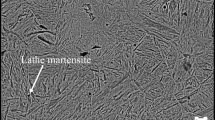Abstract
Non-transferability of fracture data from specimen level to component level is a serious limitation of conventional fracture mechanics, as fracture resistance data obtained is largely geometry dependant. The difficulty is largely overcome by GTN model which models the drop in load carrying capacity of a material with the increase in plastic strain, considering nucleation, growth and coalescence of micro-voids in the material. However, determination of the model-parameters with experiments is extremely difficult and doubtful. Hence, a parameter-study has been done to find out the effects of different parameters on material behaviour to asses the parameter for best practical result with least metallographic study. The parameters were finally verified by predicting ductile fracture in a real life piping component.
Similar content being viewed by others
References
Benzerga AA (2002) Micromechanics of coalescence in ductile fracture. J Mech Phys Sol 50: 1331–1362
Chu CC, Needleman A (1980) Void nucleation effects in biaxial stretched sheets. ASME J Eng Matl Tech 102: 249–256
Clausmeyer H, Kussmaul K, Roos E (1991) Influence of stress state on the failure behaviour of cracked components made of steel. ASME App Mech Rev 44(2): 77–92
Deiter GE (1988) Mechanical metallurgy. McGraw-Hill, New York
Dutta BK, Arora N, Saini S (2005) Application of a modified damage potential to predict ductile crack initiation in welded pipes. Int J Pres Ves Piping 82(11): 833–839
ESIS Procedure for Determining the Fracture Behaviour of Materials (1992). ESIS P2-92
Faleskog X, Shih CF (1998) Cell Model for non-linear fracture mechanics-I, micromechanics calibration. Int J Frac 89: 335–373
Gurson AL (1977) Continuum theory of ductile rupture by void nucleation and growth: part I—yield criteria and flow rules for porous ductile media. J Eng Matl Tech Trans ASME 9: 2–15
Leblond JB, Perrin G (1999) A self-consistent approach to coalescence of cavities in inhomogeneously voided ductile solids. J Mech Phys Sol 47: 1823–1841
Lievers W, Pilkey AK, Lloyd DJ (2004) Using incremental forming to calibrate a void nucleation model for automotive aluminium sheet alloys. Acta Mater 52: 3001–3007
Lievers WB, Pilkey AK, Worswick MJ (2003) The co-operative role of voids and shear bands in strain localization during bending. Mech Matls 35: 661–674
Negre P, Steglich D, Brocks W, Kocak M (2003) Numerical simulation of crack growth in aluminium welds. Comp Matl Sci 28: 723–731
Negre P, Steglich D, Brocks W, Kocak M (2004) Crack extension in aluminium welds: a numerical approach using the Gurson–Tvergaard–Needleman model. Eng Frac Mech 71: 2365–2383
Pavankumar TV, Samal MK, Chattopadhyay J, Dutta BK, Kushwaha HS, Roos E, Seidenfuss M (2005) Transferability of fracture parameters from specimens to component level. Int J Pres Ves Piping 82: 386–399
Samal MK, Dutta BK, Kushwaha HS (2000) Modelling of Ductile and Cleavage fracture by local approach. BARC/2000/E/023, BARC, Mumbai, India
Schuler X, Blind D, Eisele U, Herter KH, Stoppler W (1994) Fracture mechanics evaluation of cracked components with consideration of multiaxility of stress state. Nucl Eng Des 151: 291–305
Singh PK, Chattopadhyay J, Kushwaha HS (1997) Tensile and fracture properties of PHT piping material. BARC/1997/E/018, BARC, India.
Steglich D, Brocks W (1997) Micromechanical modelling of the behaviour of ductile materials including particled. Comp Matl Sci 9: 7–17
Steglich D, Siegmund T, Brocks W (1999) Micromechanical modelling of damage due to particle cracking in reinforced metals. Comp Matl Sci 16: 404–413
Sun DZ, Honig A (1994) Significance of the characteristic length for micromechanical modelling of ductile fracture. In: Aliabadi MH (ed) Proc 3rd Int Conf Localized Damage Comp. Mech. Publication, Southampton, pp 287–296
Tarafder S, Sivaprasad S, Tarafder M, Prasad P, Ranganath VR, Das S (2000) Specimen size and constraint effects on J–R curves of SA 333 Gr.6 steel. Technical report, National Metallurgical Laboratory, Jamshedpur, India.
Thomson CIA, Worswick MJ, Pilkey AK, Lloyd DJ (2003) Void coalescence within periodic clusters of particles. J Mech Phys Sol 51: 127–146
Tvergaard V (1981) Influence of voids on shear band instabilities under plane strain conditions. Int J Frac 17: 389–407
Tvergaard V, Needleman A (1984) Analysis of cup cone fracture in a round tensile bar. Acta Meta 32(1): 157–169
Zhang Z (1996) A sensitivity analysis of material parameters for the Gurson constitutive model. Fatigue Fract Eng Mater Struct 19(5): 561–570
Zhang ZL, Thaulow C, Ødegård J (2000) A complete Gurson model approach for ductile fracture. Eng Frac Mech 67: 155–168
Author information
Authors and Affiliations
Corresponding author
Rights and permissions
About this article
Cite this article
Chhibber, R., Biswas, P., Arora, N. et al. Micromechanical modelling of weldments using GTN model. Int J Fract 167, 71–82 (2011). https://doi.org/10.1007/s10704-010-9528-z
Received:
Accepted:
Published:
Issue Date:
DOI: https://doi.org/10.1007/s10704-010-9528-z




